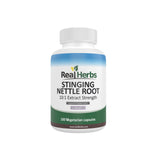How to Take Stinging Nettle Root?
Introduction
Stinging nettle root, also known scientifically as Urtica dioica, has a long history in traditional medicine and is praised for its potential health benefits. In this article, we will look at how to incorporate stinging nettle root into your health regimen in a variety of ways.
What exactly is Stinging Nettle Root?
The Urtica dioica plant, from which stinging nettle root is derived, has been used for centuries to treat a variety of health issues. Its extracts are thought to contain compounds that contribute to its health-promoting properties.
Health Advantages:
According to research, stinging nettle root may have several health benefits:
Stinging nettle root is frequently associated with improving prostate health and urinary function in men.
Compounds in nettle root may help reduce inflammation, which has been linked to a variety of chronic health issues.
Allergy Relief: Due to its anti-inflammatory properties, some studies suggest that stinging nettle root may alleviate symptoms of seasonal allergies.
Preliminary research suggests that nettle root may help with hormonal balance, particularly in relation to sex hormones.
Stinging Nettle Root Varieties:
Stinging nettle root comes in a variety of forms, allowing you to select the one that best suits your preferences and needs:
Capsules and tablets: These are convenient for accurate dosing and are frequently standardized for specific compounds.
Tea: To make stinging nettle root tea, steep dried root or leaves in hot water. This method provides a relaxing way to consume nettle.
Tinctures and extracts: These concentrated forms of stinging nettle can be added to beverages or taken directly, providing a potent way to reap the benefits of the plant.
Dosage Recommendations:
While dosage recommendations vary, a typical dosage range for stinging nettle root supplements is 300-600 mg daily. Individual responses may vary, so it is best to consult a healthcare professional before beginning any new supplement.
Stinging Nettle Root Preparation:
1. Tea made from stinging nettle root:
Pour boiling water over dried stinging nettle root or leaves.
Steep for 5-10 minutes before straining and serving.
You can flavor it with honey or lemon.
2. Supplements/Capsules:
Follow the product label's dosage instructions.
To improve absorption, take capsules with a glass of water, preferably with meals.
Extracts and tinctures:
Follow the dosage instructions on the product label.
Consume the specified number of drops with water or juice.
Precautions and Possible Adverse Effects:
When used correctly, stinging nettle root is generally regarded as safe. Some people, however, may experience side effects such as stomach upset or skin irritation. If you have allergies or are taking medications, you should exercise caution and consult a healthcare professional first.
Who Should Stay Away From Stinging Nettle Root:
Without medical supervision, pregnant or breastfeeding women, people with certain medical conditions (such as kidney problems), and people taking blood-thinning medications should avoid stinging nettle root.
Quality Product Buying Advice:
Choose products from reputable brands that meet high quality standards.
Look for independent testing and certifications.
Check the label to make sure you're getting pure stinging nettle root extract.
Conclusion:
Incorporating stinging nettle root into your diet could provide a variety of health benefits. Whether you prefer the soothing ritual of tea or the convenience of supplements, always consult a healthcare professional before making any major changes to your regimen. You can harness the potential of stinging nettle root for your health by taking a thoughtful and informed approach.












